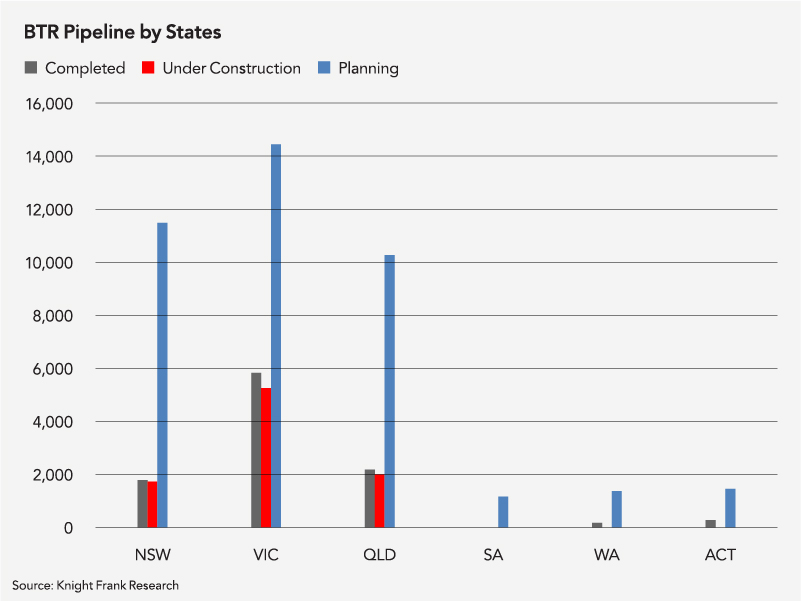Freecity Innovation Insights No.3 – Living Sector growth and the role of VMC

This week I spoke at the Future Place – Living Sectors Summit held in Sydney, it was a great opportunity to connect and hear from developers, architects, operators, investors, fund managers and suppliers from the industry. There was lots of discussion about modular construction which is music to my ears!
Here’s my key messages from my keynote presentation:
- At last Australia is looking to catchup to the rest of the world and introduce a broader Living Sector with Institutional ownership of residential for rental homes, in Build-to-Rent and Co-Living. BTR or Multi-Family is one of the largest asset classes globally, with over $10 Trillion invested in Europe and the US, but is still nascent in Australia, largely due to our love affair with home ownership and the low-yield residential attracts. Strong total returns in Australian residential markets have now attracted international capital in recent years with mixed results.
- Consultants BDO estimate the national BTR pipeline includes about 39,300 apartments across 113 projects, worth about $30bn. That represents a growth of 10,000 apartments over the past year. But these decisions to build BTR were made 2 to 3 years ago and new commencements are slowing down this year, largely due to feasibility concerns.
- For Freecity our productivity savings helps to get the cashflow moving 12 to 18 months earlier for large buildings, which is critical for feasibility. I believe the Federal Government needs to fix the GST disparity with BtS enjoying the Margin Scheme, whilst BtR is burdened by full GST upfront, together with clear pathways and incentives for Domestic Superfunds to invest in BTR (this is quite common around the world), to secure the strong potential for growth.
- NSW is coming last on the States league table for The Housing Accord, already running at -43% below its’ target in the first year and likely still dropping. Even with a strong ramp-up for house & land and medium density above record levels, the missing piece for housing in NSW is apartments. Urban renewal peaked in delivery in 2018-19 which saw apartments in NSW grow towards 40,000pa and nearly 50% of housing supply, but momentum has largely stopped, and apartment commencements are down nearly two thirds from the peak. Feasibility is limiting development to Sydney’s Northern and inner ring suburbs. BTR is the emerging sector which can fill this gap, and NSW needs to catch up to VIC.
I think there is potential for investment into Living Sector assets to get even broader, as Institutional ownership of residential assets for rent can be applied across the housing continuum, with the right enabling policies – why not social and affordable housing, perhaps more like a PPP (Public Private Partnership).

Steven Mann
Chief Strategy Officer, Freecity
Our lead Australian Modular Architect has been COX Architecture – who have designed our first three modular Student accommodation buildings (PBSA) using Volumetric Modular Construction, which all have Development Approvals through Local Council’s. Felipe Miranda – Director at COX has led this work and presented these projects at the summit. We will share with you more detail about these projects as they are delivered during next year.
Welcome to Felipe Miranda – COX Architecture.
Here’s some key thoughts from Felipe’s presentation:
Modular construction expands the possibilities and pace of design and construction, without compromising on quality.
Felipe challenges one of the most persistent misconceptions in the industry: that modular leads to generic, box-like buildings. International precedents prove the opposite; that modular can deliver refined facades, complex spatial arrangements and high-quality interiors that are as high quality as traditional builds. The outcomes achieved overseas show that modular is no longer a constraint on design, but a creative opportunity to rethink and reimagine traditional methods.
Designing for modular construction is a journey, with iterative outcomes that improve each time.
Through three projects we’re working together on, Felipe reinforces the iterative nature of modular. Like automotive or aerospace manufacturing, each project becomes a “generation” that incorporates the learnings of the one before it. Rather than reinventing the wheel with each new building, architects build a body of design intelligence that compounds over time, improving sustainability, elevating quality and increasing efficiency. It’s a genuine shift in how we think, plan, and work together.
Modular is not a pared-back version of architecture – but a sophisticated solution that can deliver the same amenity, preferences and values that people demand from their living environment.
Felipe highlights how even complex shared spaces like lounges, cafés and rooftop terraces can be successfully delivered within a modular framework. This reinforces his core message: modular should not be seen as a pared-back version of architecture, but as an exciting method capable of delivering the thoughtful, socially responsive environments housing and student accommodation now demand.


Felipe Miranda
Director, COX Architecture
Published: 14 November 2025
